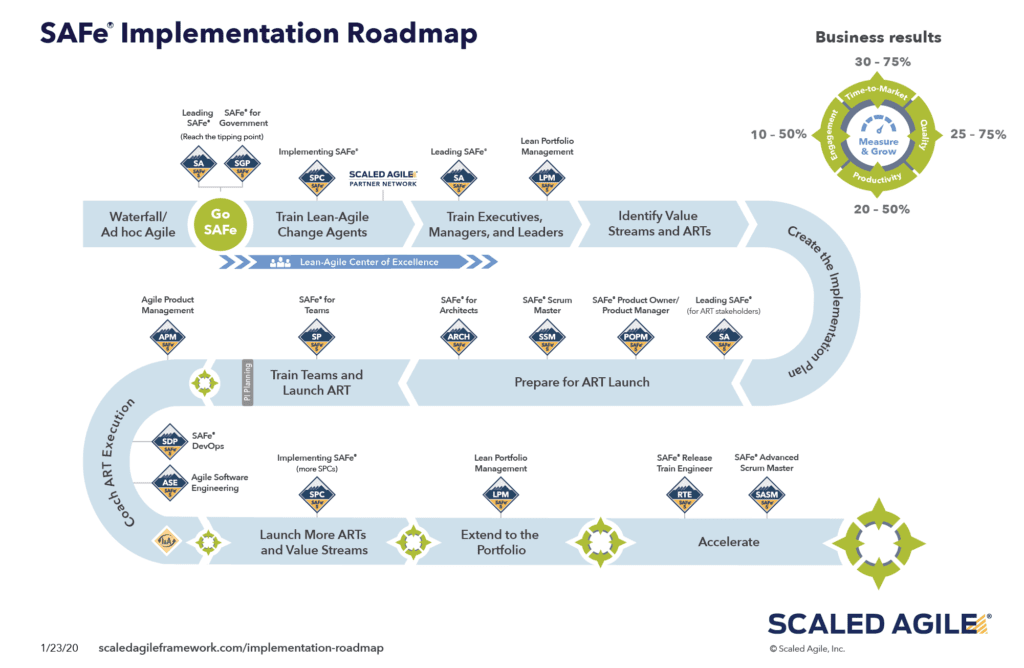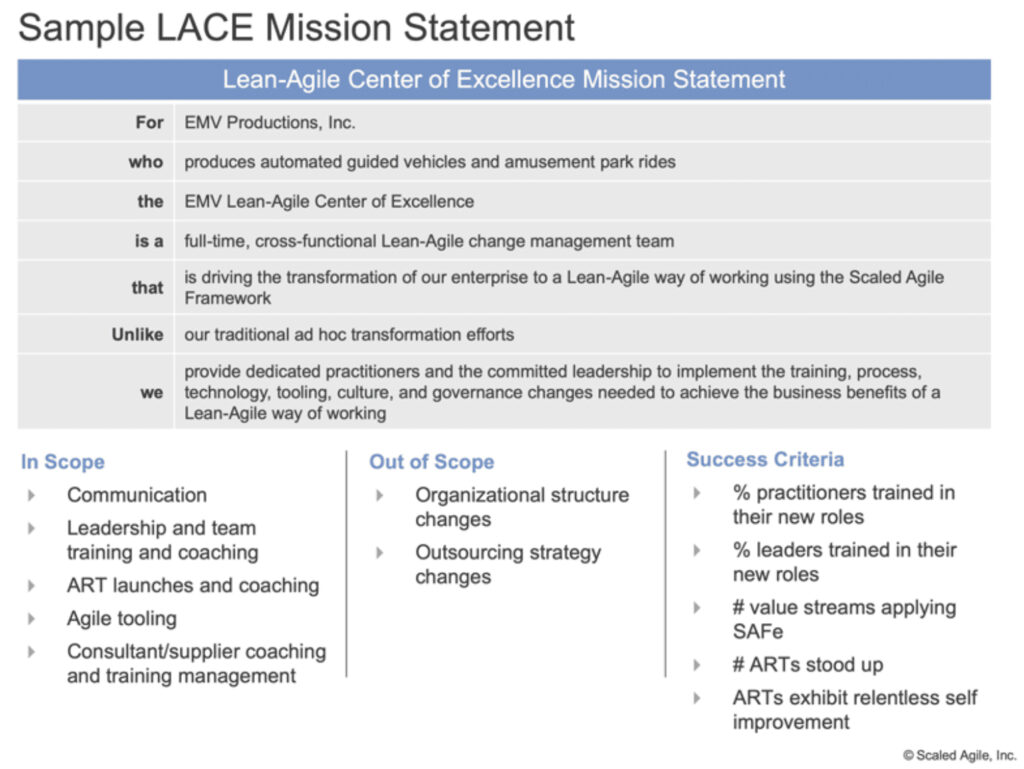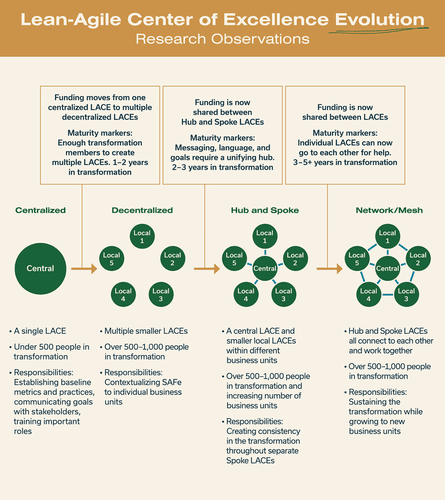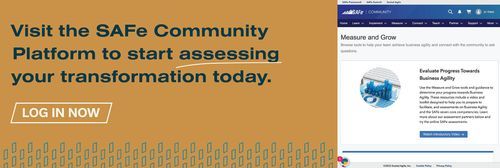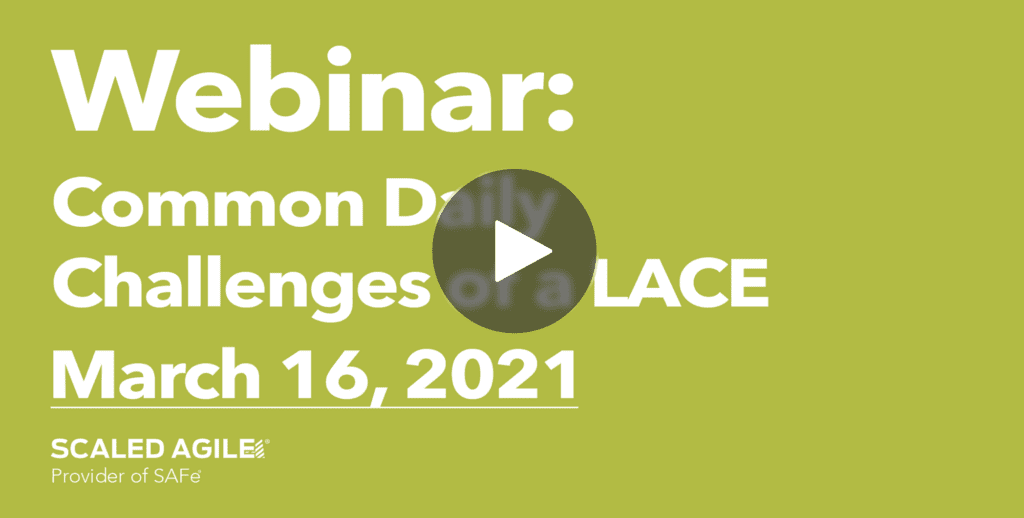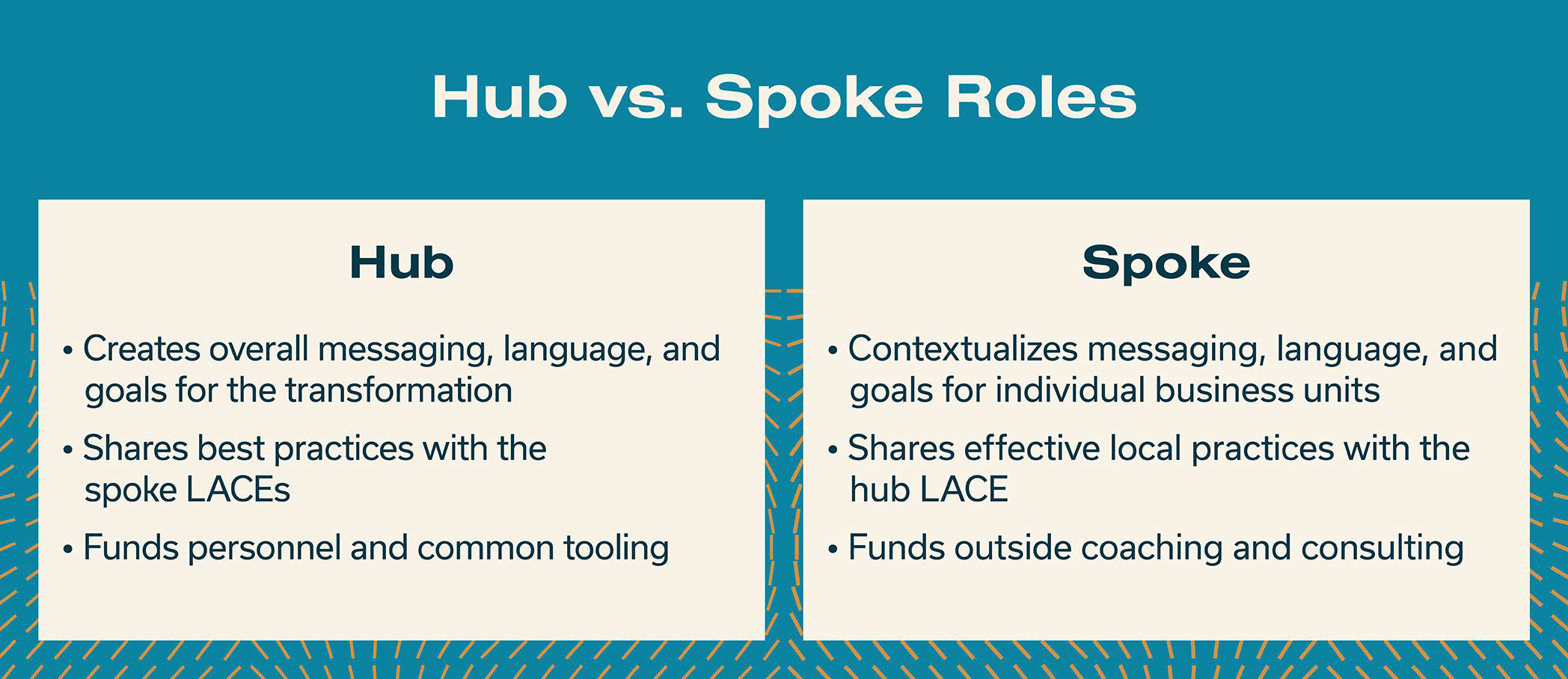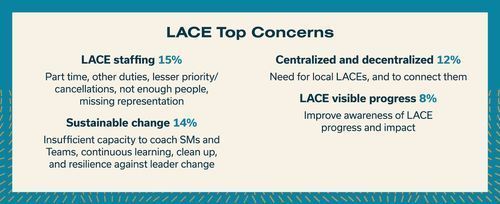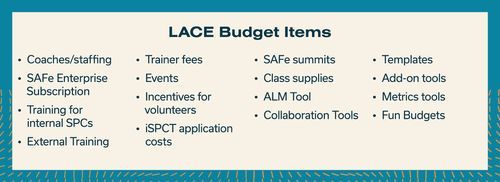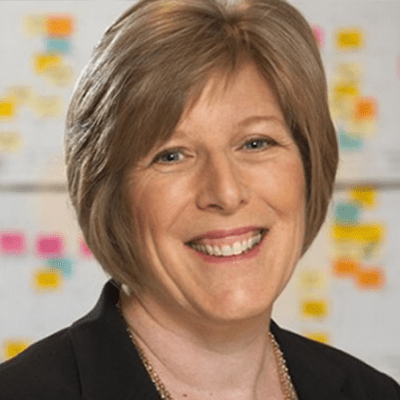Wouldn’t it be great if transformations could go on autopilot?
Unfortunately, despite what we wish for, they can’t. They need strong and resilient teams driving transformations to success.
In this blog, you’ll learn how to set up your Lean-Agile Center of Excellence (LACE) for success. Everything in this blog is from our experiences in the field.
Our story begins at the very first LACE Summit, where we met for the first time. Heads of LACE teams from across the globe were brought together, where we were able to collaborate, exchange ideas, and benefit from each other’s experiences. This took place on October 6, 2022, when Amadeus welcomed Orange, Renault, Vodafone, and Scaled Agile, Inc. to the Amadeus headquarters in Sophia-Antipolis, France.
We left the LACE summit with practical examples of
- LACE team setups
- Challenges
- Pitfalls
- Best practices
- Recommendations
The event was not only fun but a real eye-opener.
What to Consider When Setting up Your Lean-Agile Center of Excellence
We identified four focus areas when creating a Lean-Agile Center of Excellence:
- Setup
- Reporting line
- Diversity of capabilities
- Prioritization process
LACE setup
You have many options for LACE setup.
It’s important to consider your progress in the transformation journey and transformation ambition.
Most LACE teams have a Hub-and-Spoke setup. This includes relays in the organizations they support (SAFe® champions). Most LACE teams include HR and Finance in their decision process and roadmap.
Based on input from other LACE teams, it’s not easy to map a LACE organization. The organization has plenty of connections and direct or dotted links with other groups.
You usually start with a small team of change agents representing different areas. They’re willing to drive the change, experiment, and learn fast. These team members may only dedicate a limited part of their capacity to the transformation at the beginning. But they’re willing to go the extra mile.
Skills in the LACE are global and include R&D, HR, Finance, Product Management, Design Thinking, and Communication. Use external consultants as you develop the skills of your internal change agents at the start of the journey. The goal of these external partners should be to enable your LACE team to drive transformation on their own.
As the scale of your transformation increases, you will also need to scale your team. You may need to create new transformation teams to support simultaneous transformations in different areas (portfolios).
At Amadeus and Vodafone, we use the Hub and Spoke model. This enables decentralized decision-making and concurrent transformation initiatives in different areas. It also brings alignment on important transformation topics with a strong Hub.
At Amadeus, we also have SAFe champions. We nominate these champions and train them on SAFe SPC curriculum. Once trained, they become strong change agents in the organization. They sustain the change in alignment with the LACE support.
The most critical success factor when you start is nominating a strong authentic leader. This leader understands the business and the challenges the company is facing. It should be someone eager to drive the change and with energy and resilience to resolve impediments and roadblocks along the way. Pairing two leaders—one from Business and one from IT—will increase alignment of the transformation from the get-go.
Reporting lines
Since most transformations start in IT, organizations create a Head of LACE position in IT. The role usually reports to the Chief Information Officer (CIO) or Chief Technology Officer (CTO). This underpins the importance of the transformation. It also creates a direct line of communication with executives within the organization.
But, in this case, the Business Executive Sponsor is crucial to the transformation. They enable acceptance of the transformation team in the Business organization. Otherwise, there is a risk that business engagement will lack. People will perceive the transformation as IT only.
At Amadeus, there is a double reporting line of Head of LACE both to the CTO and a dotted line reporting into HR. This double reporting enables the LACE to dig into engineering perspectives. It also gives them a transversal mandate to guide the people and culture evolution.
Agile Coaches usually report to one line organization led by the Head of LACE. This ensures
- Alignment
- Consistency of implementation approach
- Fast upskilling
- Knowledge-sharing
It’s important to note that a successful LACE is a collaboration, not a line organization. The LACE needs more cross-functional and cross-departmental capabilities. These capabilities anchor the change in the organization.
Diversity of capabilities
Depending on your transformation goals and environment, you’ll need different skills and capabilities. Your transformation will evolve. This means your required skills and capabilities will also evolve. New challenges and impediments will come up.
A typical LACE team can include the following skills and capabilities:
- Agile Coaching and Training
- Agile Methods and Tooling
- Change Management and Communication
- Design Thinking
- DevOps
- Representation of Finance, HR, line managers, and change agents
In a regulatory and compliance environment, include the following experts in your LACE team:
- Tooling
- Compliance
- Process
Prioritization process
Transformation requires focus. Change agents and change champions have jobs that keep them busy. Other priorities get in the way. Transformations can feel like you’re changing tires on a highway at full speed.
To counterbalance conflicting priorities, try the following:
- Upfront investment in alignment
- Involving line managers of your change agents
- Negotiating transformation goals as part of yearly performance goals
A small team of dedicated SPCs can speed up your transformation. When you start to scale on an enterprise level, the impediments will get bigger and harder to address.
At Amadeus, the LACE runs the transformation. They use SAFe Lean Portfolio Management (LPM) for prioritization. They use an Agile Release Train for the execution.
A Strategic Portfolio Review (SPR) drives the transformation LPM. The SPR includes executives from all business units. These executives share:
- Priorities
- Roadmap
- Major achievements
- Impediments where the LACE needs top management support
Amadeus holds the SPR quarterly.
They also organize bi-weekly Portfolio Sync meetings. These meetings include executive representatives. They address Epics and operational progress of the transformation train.
Some of the SPR members are also Business Owners of the transformation train. This generates better alignment and valuable discussions with the team members.
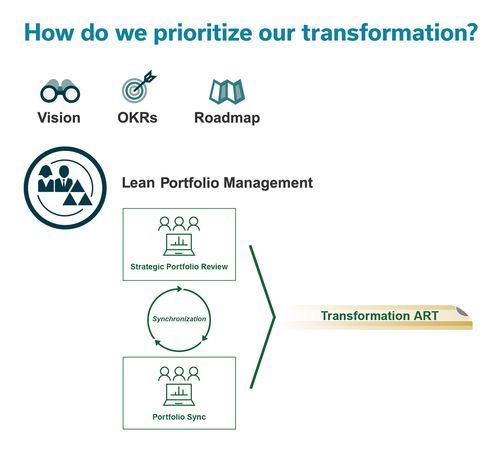
Lean-Agile Center of Excellence Challenges and Tips
The Lean-Agile Center of Excellence will face challenges throughout the transformation journey. The following two challenges are particularly critical to overcome.
- Executive engagement
- Transformation ownership
Challenge 1: Executive engagement
Transformation is not a sprint but a marathon. It’s not enough for executives to give their buy-in at the beginning of the transformation. They shouldn’t expect business results with minimal effort.
Many transformation teams struggle to get continuous executive engagement needed for sustainable change.
To keep executives engaged, always start with the WHY. Define the clear business outcomes you want to achieve. You don’t need to get engagement from all executives at once from the very beginning. Start with one. Build trust. Show quick incremental improvements, and let them become your biggest advocate.
Challenge 2: Transformation ownership
As the LACE team, avoid becoming a ‘Doctor’s office’. People should not come to you for quick pain relief and fast results with the least effort. With this method, if something is not working, it immediately becomes your fault.
Ownership of the transformation and business results should stay in the delivery organization. The LACE team is an enablement team. They partner with different business areas to
- Become a catalyst of change
- Drive continuous improvement culture
- Help address roadblocks on the way to success
Tips for solving these challenges
Here are some tips for solving the two challenges mentioned in the previous section.
Engage your executives in your roadmap
Train executives. Coach them. Involve them in the planning through retrospectives, system demos, and other formats.
Why is this important?
You’ll need their support to get everyone on board. Then you’ll need their approval (and even more so, their sponsorship) to implement changes in the organization.
Don’t get out of breath
You are of no use if you run out of energy. Take time with your work. Make sure your teams have the right workload to avoid feeling like they’re gasping for air. Don’t be too wrapped up in meeting your own goals and forget to engage your team.
Changing for the sake of change won’t be enough for your teams
People need a compelling reason to change. Engage colleagues by building a vision and defining a burning platform. We’ve seen this work in many transformation journeys.
Change agents should work as a team and support each other
Organizational transformation is tedious work, and it is not a one-person job. Use PI (Planning Interval) planning to align priorities. Ensure the team works toward the same objectives.
Celebrate success together as a team and boost motivation
Short-term wins encourage team members to be more engaged and positive about the work.
Some people believe SAFe and agility are for technical people, like engineers. But this is not always true. Practicing Agile ways of working means planning work and delivering value based on the customer’s wishes. By this, all aspects of a company should be Agile.
So, your transformation team needs representation from everywhere. This includes business, HR, Finance, Procurement, and more. They will be your change agents in different areas of the business.
A Checklist to Keep Your LACE on Track
Setting up a LACE team can be overwhelming. Oftentimes, as an internal team, you may only have one chance to get it right.
Here’s a checklist based on experience from the trenches to help your LACE team get it right on the first try.
1. Design a purpose-driven transformation that ensures continuous executive engagement.
- Secure a transformation sponsor at the executive level
- Define common objectives (OKRs) with your sponsor
- Connect to strategy and define transformation narrative
- Involve executive leaders in prioritizing the LACE backlog of transformation initiatives
2. Define and evolve your LACE vision/mission, transformation scope, capabilities needed, and your operating model.
- Host a LACE Kickoff to define your vision, mission, ways of working, initial scope, and metrics
- Ensure nomination of HR and Finance representatives and establish a good mix of Business and Technology representatives in your LACE team
- Co-create transparent rules of engagement between your LACE team and transformation the initiatives you’re supporting
- Join forces and connect with the strategy team in your organization, Cultural Center of Excellence, or Digital Transformation office (when applicable) to support broader enterprise transformation and cultural change
- Drive alignment on vision, mission, and why story when you scale across the organization and make your transformation inclusive to all transformation teams
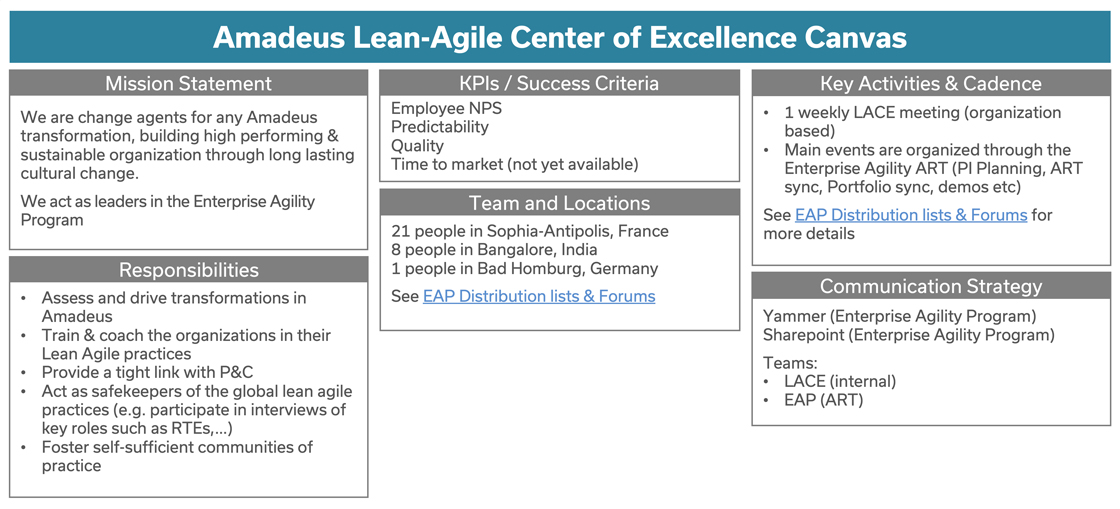
3. Invest time in communication, focusing on different and sometimes unique needs of stakeholders. Remember, there is no successful transformation without successful communication.
- Create an engaging communication strategy and communication plan for different target groups
- Experiment; be bold and creative
- Promote transformation stories, testimonials, and learnings in different formats (e.g. regular demos, newsletters, videos, podcasts, etc.)
- Organize regular Agile events or internal Agile conferences to bring your transformation stories to life and connect change agents and enthusiasts in the organization
- Don’t forget that executives represent a crucial communication target group; invest time in understanding their communication needs
4. Adapt to change, scale with alignment, and measure success.
- Evolve your transformation scope over time and adjust your LACE capabilities depending on the current focus area of transformation
- Scale transformation with SPC Champions in different areas and connect them via Community of Practice to drive excellence, community spirit, and pride in driving transformation together
- Measure NPS of your LACE team for different transformation initiatives you are supporting
Additional LACE Resources
If you’re interested in setting up and driving a successful LACE, we would love to invite you to the next edition of the LACE Summit. It will be planned at Amadeus Sophia-Antipolis, France in October 2023. Join us to hear and share about your favorite topic. Stay tuned!
Here are some additional LACE resources:
- How to Start and Grow Your Lean-Agile Center of Excellence blog
- LACE and Transformation forum
- Running the transformation using a SAFe Agile Release Train article
- SAFe Enterprise page on SAFe Studio
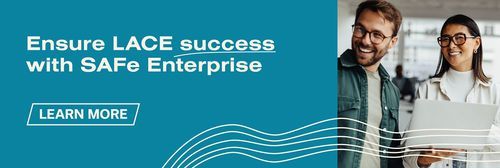
About Sandra Bellong

Sandra Bellong, Head of Lean-Agile Center of Excellence at Amadeus, is a senior people manager, project manager, and Agile/SAFe specialist with a strong background in business analysis and development design. She is a dynamic, engaged, and motivated actor in Agile transformations, process and methodology improvements, and always in the scope of high customer satisfaction.
Connect with Sandra on LinkedIn.
About Alena Keck
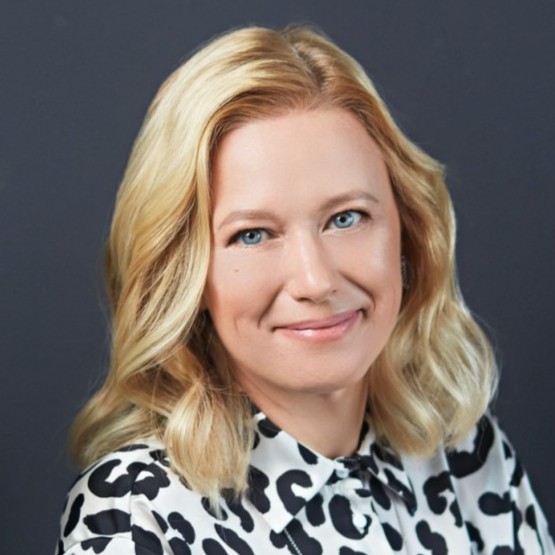
Alena Keck, Head of Lean-Agile Center of Excellence at Vodafone, is passionate about helping large global companies reach the full potential of business agility and overcome challenges of Agile transformation at scale. Her mission is to be a strong change agent who creates strong transformation teams and growing Lean-Agile leaders. Her motto is “Transformation is a Team Sport.”
Connect with Alena on LinkedIn.




